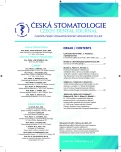Er: YAG Laser Contact and Non-Contact Delivery Systems Cavity Preparation and Sonic-Activated Bulk Composite Restoration
Authors:
H. Jelínková 1
; M. Bučková 2; T. Dostálová 2; M. Kašparová 2; J. Šulc 1; Martin Němec 1
; P. Bradna 3
Authors‘ workplace:
Stomatologická klinika dětí a dospělých 2. LF UK a FN Motol, Praha
1; Fakulta jaderná a fyzikálně inženýrská ČVUT, Praha
2; UKES 1. LF UK a VFN, Praha
3
Published in:
Česká stomatologie / Praktické zubní lékařství, ročník 114, 2014, 3, s. 67-71
Category:
Original Article – Experimental Study
Overview
Introduction:
The comparison of tissue quality and its restoration after contact, and non-contact Er: YAG (2940 nm) laser radiation ablation was evaluated.
Methods:
Laser setting for contact ablation was 250 mJ/pulse, pulse repetition rate 15 Hz, average power 3.75 W. For non-contact ablation these values were: 600 mJ/pulse, 6 Hz, 3.6 W. Structure of enamel and dentin after laser ablation was analyzed in scanning electron microscope. All cavities were filled by sonic-activated composite resin. Chemical and mechanical bond was observed in scanning electron microscope.
Microleakage was assessed quantitatively by the degree of methylene blue dye penetration. Fischer exact test (p < 0.05) was used for statistical evaluation.
Results:
Contact and non-contact laser treatments prepared similar cavities (5167.31 μm versus 5356.31 μm).
Defocusing of non-contact therapy has direct influence on the dye penetration microleakage presence (481.19 μm versus 611.94 μm) but this increase was not statistical significant.
Conclusion:
Cavity prepared by contact mode with sonic-activated composite filling protects microleakage formation.
Key words:
dentistry – Er: YAG laser – sonic activated composite material
Sources
1. Diaci, J., Gaspirc, B.: Comparison of Er:YAG and Er,Cr:YSGG lasers used in dentistry. J. Laser Health Academy, roč. 1, 2012,
č. 1, s. 1–13, www.laserandhealth.com.
2. De Moor, R. J., Delmé, K. I.: Laser-assisted cavity preparation and adhesion to erbium-lased tooth structure: part 1. Laser-assisted cavity preparation. J. Adhes. Dent., roč. 11, 2009, č. 6,
s. 427–438.
3. Dostalova, T., Jelinkova, H.: Lasers in dentistry: overview and perspectives. Photomedicine and Laser Surgery, roč. 31, 2013,
č. 4, s. 147–149.
4. Kim, M. E., Jeoung, D. J., Kim, K. S.: Effects of water flow on dental hard tissue ablation using Er:YAG laser. J. Clin. Laser Med. Surg., roč. 21, 2003, č. 3, s. 139–144,.
5. Buckova, M., Kasparova, M., Dostalova, T., Jelinkova, H., Sulc, J., Nemec, M., Fibrich, M., Bradna, P., Miyagi, M.: Er:YAG and CTH:YAG laser radiation: contact versus non-contact enamel ablation and sonic-activated bulk composite placement. Laser Physics., roč. 23, 2013, č. 5, Article Number: 055605.
6. Ferreira, L. S., Apel, C., Francci, C., Simoes, A., Eduardo, C. P., Gutknecht, N.: Influence of etching time on bond strength in dentin irradiated with erbium lasers. Lasers Med. Sci., roč. 25, 2010, č. 6, s. 849–854.
7. Baghalian, A., Nakhjavani, Y. B., Hooshmand, T., Motahhary, P., Bahramian, H.: Microleakage of Er:YAG laser and dental bur prepared cavities in primary teeth. Lasers Med. Sci., roč. 28, 2013, č. 6, s. 1453–1460.
8. Obeidi, M. S., McCracken, P. R., Liu, M. S., Litaker, P., Beck, P., Rahemtulla, F. Enhancement of bonding to enamel and dentin prepared by Er,Cr:YSGG laser. Lasers Surg. Med., roč. 41, 2009, č. 6, s. 454–462.
9. DENTSPLY Caulk. SureFil SDR Flow Technical Product Profile. Clinician Information CD, October 2010.
10. De Moor, R. J., Delme, K. I.: Laser-assisted cavity preparation and adhesion to erbium lased tooth structure: part 2. present-day adhesion to erbium-lased tooth structure in permanent teeth. J. Adhes. Dent., roč. 12, 2010, č. 2, s. 91–102.
Labels
Maxillofacial surgery Orthodontics Dental medicineArticle was published in
Czech Dental Journal

2014 Issue 3
- What Effect Can Be Expected from Limosilactobacillus reuteri in Mucositis and Peri-Implantitis?
- The Importance of Limosilactobacillus reuteri in Administration to Diabetics with Gingivitis
Most read in this issue
- Use of Factory-Prepared Equimolar Mixture Nitrous Oxide/Oxygen in Paediatric Dentistry
- Comparison of Mono-Layer and Two-Layers Phantom Teeth Used in Preclinical Courses
- The Assessment of the Biocompatibility of Dental Alloys and Alloys for Dental Amalgam. Part First
- Er: YAG Laser Contact and Non-Contact Delivery Systems Cavity Preparation and Sonic-Activated Bulk Composite Restoration
